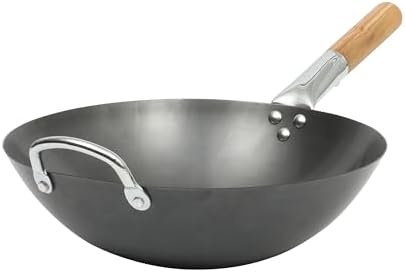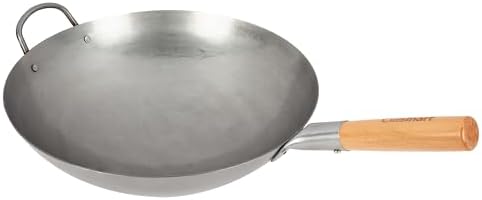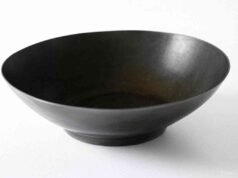Knowing Wok Materials
The material of a wok generally determines its cooking performance, longevity, and maintenance when you select a wok. Carbon steel, cast iron, stainless steel, and non-stick coating are the most popular materials used by wok manufacturers. Each of these materials possesses unique properties that are appropriate for different cooking techniques.
Professional cooks like carbon steel woks because they conduct heat exceptionally well and are sensitive to changes in heat. Carbon steel woks heat quickly and evenly, allowing the precise control required in methods such as stir-frying. You must season them, however, to prevent them from being sticky, and dry them immediately after washing them so that they won’t rust.
Cast iron woks also provide better heat retention but are heavier compared to carbon steel woks.
They are very durable and can withstand high heat for an extended period of time. Some cast iron woks come pre-seasoned, which improves their non-stick properties right out of the package. Although they provide better heat retention, they also require the same maintenance as carbon steel woks and take longer to heat up.
Stainless steel woks are corrosion-resistant, rust-resistant, and durable. They are not as good at conducting heat as carbon steel or cast iron but provide a non-reactive surface that is well suited to cooking acidic foods. They may not provide the same responsiveness to heat as other materials, which can impact techniques like stir-frying that capitalize on high, direct heat.
Lastly, non-stick woks are convenient to use and require minimal oil for cooking. Making them appealing to individuals who prefer ease of use. Their performance can be relatively inconsistent based on the quality of the coating used, and they tend not to perform as well at high heat as the traditional materials. Understanding the pros and cons of each wok material will go a long way in ensuring. You make a highly informed purchase decision that will suit your cooking needs and expectations.
Wok Sizes and Shapes: Finding the Right Fit
When you select a wok, it helps to know the various shapes and sizes because they significantly affect cooking performance and compatibility with your kitchen setup. The round-bottom wok, being the traditional wok, is designed for stovetop cooking with concentrated heat points, such as gas burners. This shape allows for efficient heat distribution and offers a natural stirring motion while stir-frying. A flat-bottom wok, however, is better suited for electric or induction stovetops, as this offers a flat base and a nearer approach to heating elements. Both styles offer unique advantages that can enhance your cooking experience.
Woks typically range from 10 to 16 inches in diameter when it comes to size. The size you choose should align with the amount you’ll be cooking and the number of servings you normally prepare. A smaller wok may be ideal for singles and small families, allowing quick stir-frying of vegetables and protein. Larger woks, however, provide the space for batch cooking and can support bigger meal preparation, so they are more ideal for family dinners and get-togethers.
The other important factor is the depth of the wok. Deeper woks allow for more space for ingredients, minimizing the risk of spilling and enabling you to cook with larger amounts of food. Consider the weight of the wok as well; lighter woks can be more convenient to use, while heavier ones can offer better heat retention and cooking stability.
Lastly, when choosing a wok, consider both its shape and size according to your specific cooking styles and kitchen equipment. Having these in mind will enable you to choose a wok that not only fits your stovetop but also one that will facilitate your cooking tasks effectively.
Key Features to Look for
Selecting the right wok relies on some key features that significantly contribute to its performance and overall cookware experience. Among the most critical aspects to consider is the ergonomic handle design. Properly designed handles offer balance during cooking, enabling home cooks to toss food conveniently. In addition, well-crafted handles foster safe storage, as they allow users to hold the wok securely without slipping or accidental scalding.
The other important aspect to keep in mind when purchasing a wok is its weight. A heavier wok retains heat better, distributing it evenly across its surface. This can lead to improved cooking, particularly when stir-frying. Lighter pans, while easier to maneuver, may not be capable of achieving high heat, which is necessary for achieving that good sear in stir-fried dishes. Therefore, you should choose a well-balanced wok that offers a suitable weight to achieve the best cooking result.
Compatibility with various heat sources is increasingly important in kitchens nowadays. A majority of the new woks are induction cooktop compatible, which requires specific materials to conduct heat effectively. Invest in a wok that will not only perform well on electric or gas ranges but also on induction systems without sacrificing performance. Such compatibility guarantees greater versatility in cooking to adapt to different cooking setups.
In addition, modern woks now come with extra features, including lids and steaming racks, that can really make a big difference in their usability. Such add-ons enable steaming, braising, or even slow cooking in the wok itself, thereby rendering it a multi-purpose kitchen utensil. Taking these facts into consideration, a properly selected wok can turn into a valuable possession. Taking your cooking habits and meal preparations to a new level.
Tips for Maintaining Your Wok
Caring for your wok is important for it to last longer and function at its best. With proper care, a big difference can be experienced, particularly with cast iron or carbon steel woks, as they need special care methods. Firstly, seasoning your wok is important. Seasoning not only improves the non-stick capabilities but also keeps rust at bay. To season your wok, clean it thoroughly with hot water and a soft scrubber and dry it completely. Then apply a thin coat of oil and heat the wok over medium-high heat until the wok starts to smoke. You have to repeat the process several times to build a good non-stick coating.
It is also necessary that you clean your wok after each use. Even though you might be tempted to use soap, it is generally not advisable since it will strip the seasoning. Simply rinse your wok with warm water and wipe off food bits using a soft sponge or brush. If there are some stubborn bits, try to sprinkle salt on the surface and scrub it gently. Always dry the wok completely after cleaning to avoid moisture accumulation, which leads to rust.
Storage is also something you should not overlook
To prevent scratching and maintain the seasoning, store your wok in a cool, dry area. Putting a paper towel or rag between the wok and any other pots and pans will pad the surface. Also, never submerge your wok in water or leave it in a damp area, as this will cause rust and ruin the seasoning.
Prevent typical mistakes, such as overheating the wok or using metal utensils, since they will also reduce its lifespan. It’s advised to use silicone or wooden utensils to preserve the wok’s surface. By using these handy care guidelines, you’ll be able to enjoy the advantages of your wok for an extended period. Adding to your cooking experiences and tastes.












[…] Choosing a wok is not just a case of material or shape size matters too. Woks exist in a number of various diameters, typically between 10 and 16 inches, and the size will actually have an impact on cooking performance, ease of use, and what you can prepare. […]
[…] Read article: Things to Consider When Choosing a Wok: Features and Tips for Buying the Perfect Wok […]
[…] especially when it comes to cookware. If you’re a stir-fry enthusiast or considering buying a wok, you might wonder: Can I safely use a wok on my glass top stove? The answer is yes but only if you […]